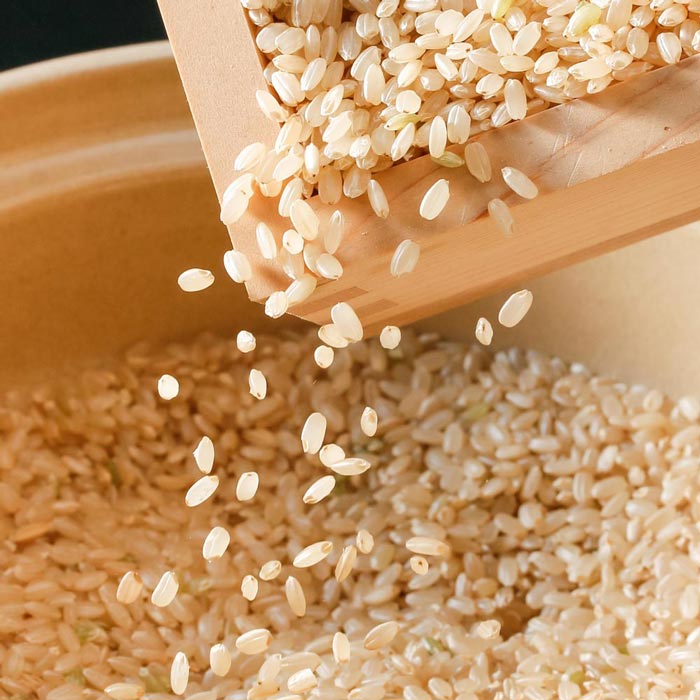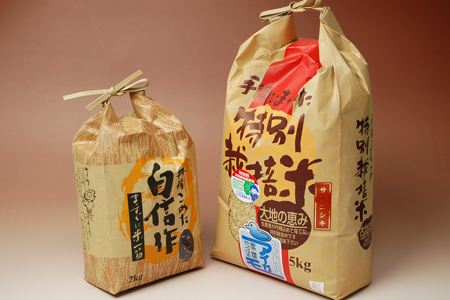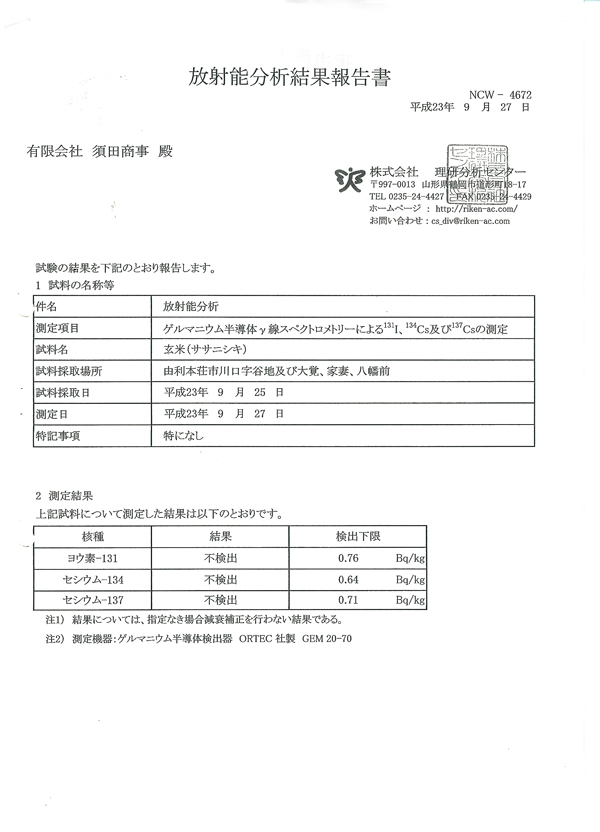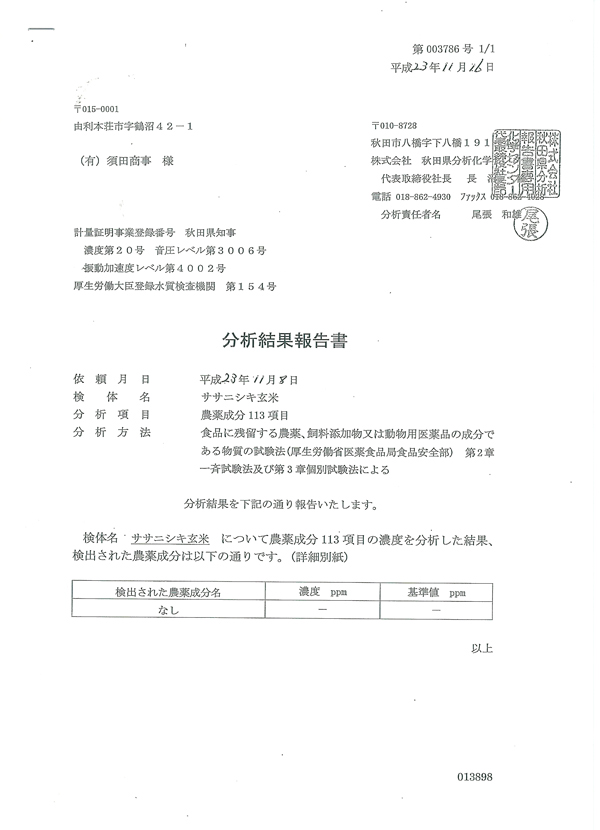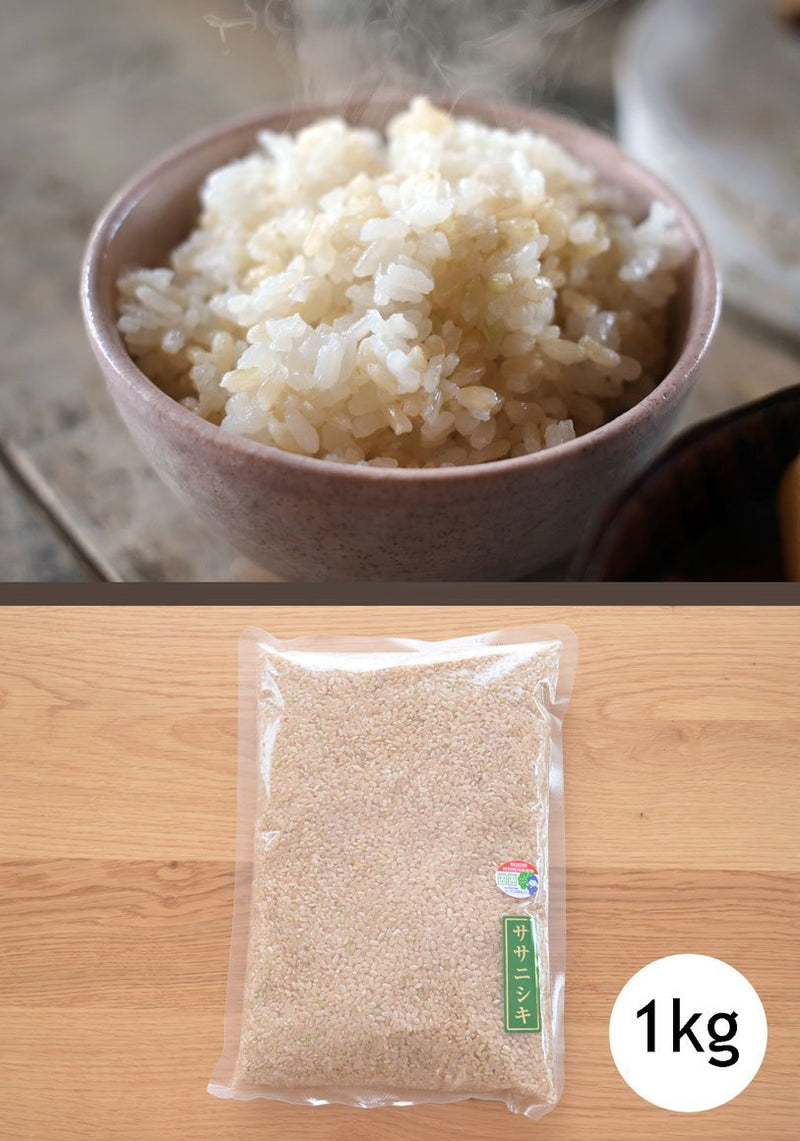
Pesticide-Free "Sasanishiki" Brown Rice 1 Kg
Out Of Stock
Important Notice Regarding Grains and Beans Shipments
Before purchasing our grains and beans, confirm their eligibility for import into your country. These products may face customs clearance challenges due to varying international regulations. Orders returned due to non-compliance with local import laws will incur a round-trip shipping charge. No refunds or reshipments.
Thank you for understanding.
About Pesticide-Free
"Sasanishiki" Brown Rice
It is an pestice-free "Sasanishiki" Brown Rice that cultivated without any pesticides, chemical fertilizers, fungicides, and post-harvest pesticides.
Once you taste this rice's moderate stickiness, deep sweetness, and firm grain texture, you will never get satisfied with Normal Rice The.
Because It Is Rich In Nourishment, This Rice Is Recommended For Those Who Want A Healthy And Well-Balanced Diet.

The Pesticide-free "Sasanishiki" Brown Rice is characterized by moderate stickiness and mild texture. Each one of the grains is firm and has an attractive chewing texture.
It is perfect rice for making fried rice or risotto.
Please chew the firm texture and enjoy The delicious taste by all means.
* We only deliver a safe and secure product that have passed The Radioactive Substance Inspection (passed without detection), and Pesticide Residual Inspection (113 items passed successfully).
Therefore, this product is safe to be consumed by children and pregnant woman.
How to Deliciously Cook Brown Rice (3 Ways)
Lately, health-conscious people beginning to take an attention and change their rice intake to brown rice. Do you wonder why?
Brown rice (brown rice, genmai) is a whole-grain rice which only the husk Let's embrace the health benefits that brown rice has to offer and learn how. Is removed. The remained bran and germ part of the grain is the source of brown rice's abundant nutrients. to cook brown rice!
Go to the article >>
The Nutritional Value of Pesticide-Free "Sasanishiki" Brown Rice
There are so many nutrients inside this Pesticide-Free "Sasanishiki" Brown Rice's grain.
You can get vitamins and minerals equivalent to four grains of white rice with one grain of brown rice.
Furthermore, this pesticide-free brown rice contains dietary fiber, phytic acid, inositol, ferulic acid,
It contains many active ingredients such as gamma-oryzanol,
It is also effective in preventing obesity and colon cancer.
This rice is very recommended for those who wants to have a balance diet and healthy life everyday.
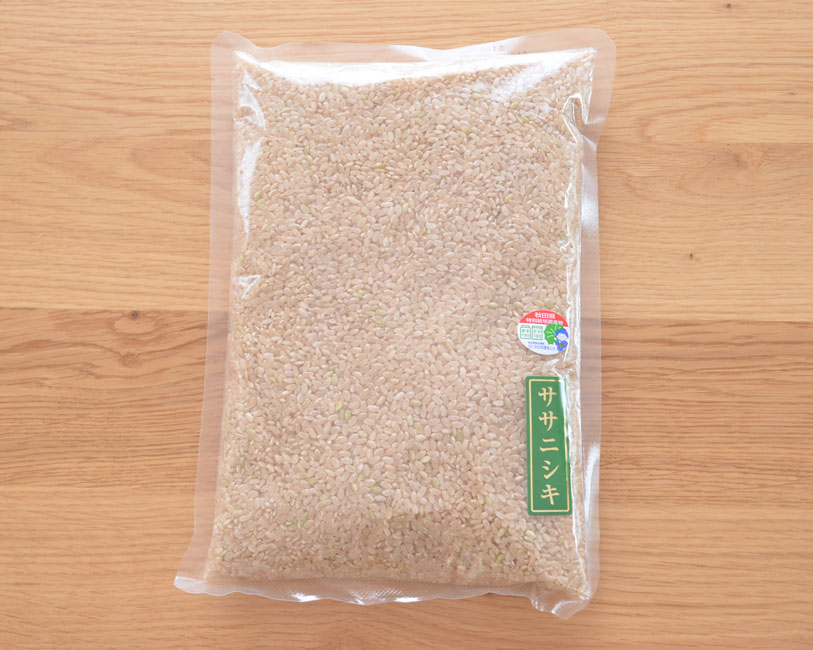
The Nutritional Value Table
| Composition | White Rice (100g) | Brown Rice (100g) | Comparison of brown rice with white rice |
|---|---|---|---|
| Energy | 356Kcal | 350Kcal | 98.3% |
| Protein | 6.1g | 6.8g | 111.5% |
| Lipid | 0.9g | 2.7g | 300% |
| Carbohydrate | 77.1g | 73.8g | 95.7% |
| Ash Content | 0.4g | 1.2g | 300% |
| Sodium | 1 mg | 1 mg | 100% |
| Potassium | 88mg | 230mg | 261.4% |
| Calcium | 5mg | 9mg | 180% |
| Magnesium | 23mg | 110mg | 478.3% |
| Phosphorous | 94mg | 290mg | 308.5% |
| Iron | 0.8mg | 2.1mg | 262.5% |
| Zinc | 1.4mg | 1.8mg | 128.6% |
| Copper | 0.22mg | 0.27mg | 122.7% |
| Manganese | 0.8mg | 2.05mg | 256.3% |
| Vitamin E | 0.2mg | 0.3mg | 150% |
| Vitamin B1 | 0.08mg | 0.41mg | 512.5% |
| Vitamin B2 | 0.02mg | 0.04mg | 200% |
| Niacin | 1.2mg | 6.3mg | 525% |
| Vitamin B6 | 0.12mg | 0.45mg | 375% |
| Folic acid | 12μg | 27μg | 225% |
| Pantothenic acid | 0.66mg | 1.36mg | 206.1% |
| Dietary fiber (water soluble) | - | 0.7g | - |
| Dietary fiber (insoluble) | 0.5g | 3.0g | 600% |
Source: Science and Technology Agency Resource Survey Committee
"Standard Tables of Food Composition in Japan (Fifth Revised Edition)"
Mix your brown rice with black rice for better nutrition
If you want to get higher nutritional value, we recommend you to mix and eat the "Sasanishiki" Pesticide-Free Brown Rice with The Special Cultivation Ancient Grain (Black Rice) from Yuri Honjo City.
Cook 1-2 tablespoon of black rice with 1 cup of brown rice.
By mixing these two type of rice, you will be able to enhance the texture of the rice.
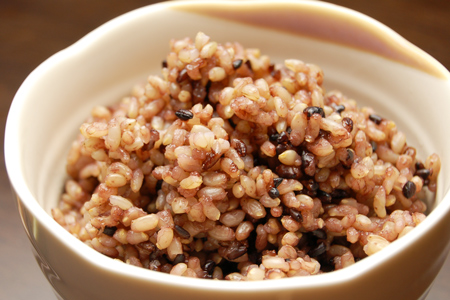
It is recommended to purchase the set of "Sasanishiki" Pesticide-Free Brown Rice 5 kg + The Special Cultivation Ancient Grain (Black Rice) 2 kg Set.
Click here to see the product's page →
Customer's Review
We received many compliments from customers. Thank you so much.
At first there was a sense of discomfort both in appearance, texture and taste, but once you get used to it you are not bothered at all.
On the contrary, I really like it.
Now, it doesn't feel right to eat white rice for mealtime.
It feels disappointing to eat white rice when eating out, and I no longer eat bread at home, too.
It's delicious.
I have good stomach condition because I've been eating brown rice for a long time.
There are many things that brown rice has a peculiarity in the smell, but I like this sasanishiki brown rice because there is no peculiarity at all. I also like texture when chewing.
It is delicious brown rice. Even my husband who doesn't really like brown rice eats this well.
The packing is neat, and dispatch is quick and satisfactory.
I will repeat on purchasing.
Because it is free shipping (in Kawashima The Japanstore's Japan website), I bought 2 kg for a trial.
It was easy to eat and I was relieved.
Next time I will buy 10kg.
Our family likes brown rice. We especially like this sasanishiki brown rice.
It looks very good for our body, so it's a good thing.
How to Wash, Cook, and Eat Brown Rice
1. How to Wash Brown Rice
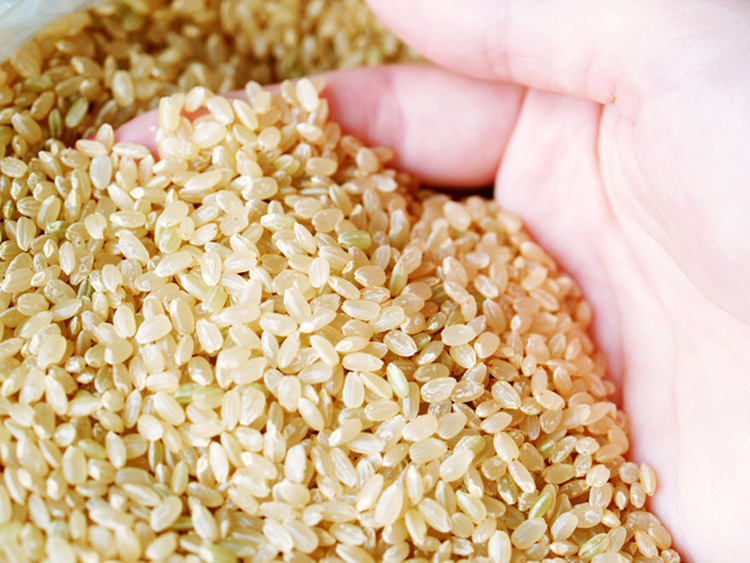
How to wash brown rice is slightly different from white rice.
There is a waterproof membrane in a thin skin which wraps the brown rice, which makes the water is less likely to penetrate when cooking compared to white rice.
So the point when washing brown rice is to carefully scratch this skin to make it easy for water to penetrate brown rice.
The tips for washing the brown rice is wrapped the brown rice with both hands and rub your hands together.
By doing this, the brown rice rubs against each other, leave the skin scratched so the water can penetrate well.
Soak your washed brown rice in water for 1 hour (2-8 hours if possible).
This will make the brown rice cooked more deliciously.
2. How to Cook Brown Rice
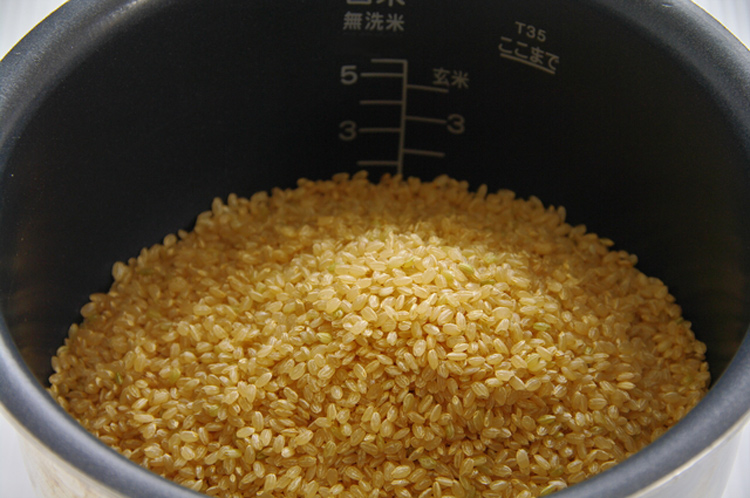
If you want to cook brown rice with a rice cooker,
put twice more water to the rice cooker with the scale when cooking white rice.
Please cook it in "Brown Rice Cooking Mode" if you have such option in your rice cooker.
If you don't have it, it is fine to cook in the normal mode.
In case if you do not like the smell of brown rice, adding a pinch of salt before cooking will be good solution.
This way, the aroma of brown rice can be suppressed.
If you are not used to eat brown rice, mix brown rice and white rice.
This way, you will be able to eat it deliciously.
For first timers, it may be good to start with the ratio of 8:2 (White Rice : Brown Rice).
3. How to Eat Brown Rice
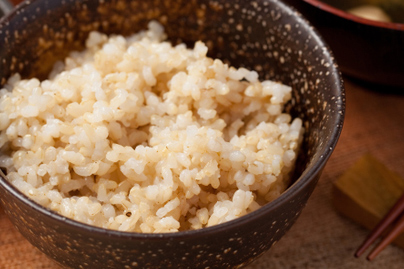
After cooking, steam the brown rice for a while without opening the lid of the rice cooker.
The most delicious timing to eat the brown rice is the 15 minutes after cooking, or when it reaches about the human body's temperature.
Brown rice has a firmer texture than white rice, and you can feel the delicious taste as you bite.
Because brown rice has deeper sweetness when you bite it rather than white rice,
please chew well (more than 30 times if possible) and eat it.
About The Pesticide-Free "Sasanishiki" Brown Rice
It is one kind of rice produced by the combination of Hatsunishiki and Sasashigure in 1963 (Showa 38th Year).
Because the Sasanishiki rice is weak to damage caused by cold weather, the production is decreasing and pushed by other rice like Koshihikari rice and Hitomebore rice.
Because of its moderate stickiness and mild texture, this Sasanishiki rice is still used by many restaurants and sushi shops.
There is also a feature that the deliciousness is hard to fall even if it gets cold.
Therefore, the Sasanishiki rice is fit for Japanese people's body and for those who want to take macrobiotics that benefits our body.
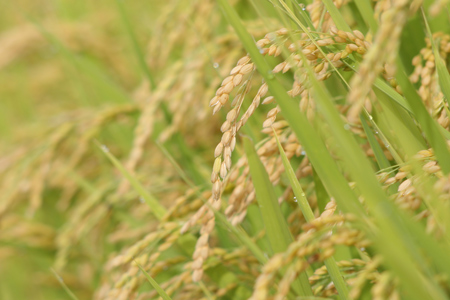
The pesticide-free "Sasanishiki" brown rice produced by Yuri Honjo City is an organic rice cultivated without any pesticides, chemical fertilizers, fungicides, and post-harvest pesticides (pesticides to be applied to grains after harvest).
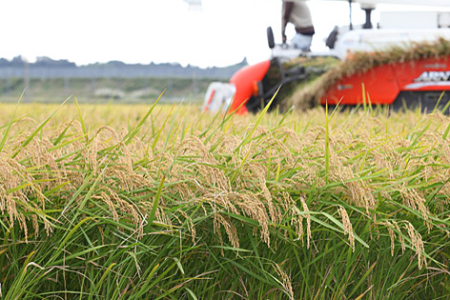
Pesticide-Free "Sasanishiki" Brown Rice is
a Radioactivity Analyzed Product
The pesticide-free Sasanishiki brown rice produced by Yuri Honjo City is a product that has been tested for radioactivity analysis. (Iodine - 131 / cesium - 134 / cesium - 137).
All three exams result is passed without detection.
This product is safe to be consumed by children and pregnant woman.
【 Measurement Result 】
・ Cesium - 134: Not detected (Detection limit: 0.64 Bq / kg)
・ Cesium - 137: Not detected (Detection limit: 0.71 Bq / kg)
* Open the image in new tab to see the enlarged screen
- RIKEN National Research and Development Institutes -
Pesticide-Free "Sasanishiki" Brown Rice is
have been Analyzed for Pesticide Residue Simultaneously
The pesticide-free Sasanishiki brown rice produced by Yuri Honjo City is a product that has been tested for Pesticide Residual Inspection.
The pesticide components for all 113 items are all undetectable.
This product is safe to be consumed by children and pregnant woman.
* Open the image in new tab to see the enlarged screen
- Analysis by Toray Research Center, Inc. (Akita Prefecture) -
About The Sasanishiki Brown Rice's Cultivation
This pesticide-free Sasanishiki brown rice produced by Yuri Honjo City is cultivated in the blessed land full with a high quality and abundant water veins of Mount Chōkai, the soil of rice fields is suitable for making delicious rice.
In addition, most of the rice fields are located in the valley which has temperature difference that can provide suitable conditions for rice growth and harvest.
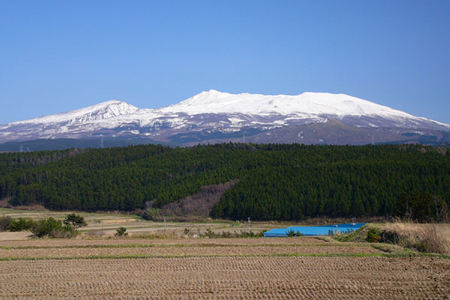
The Sasanishiki brown rice cultivated in the most suitable soil for rice production is cultivated with four farming methods.
1. Natural Return Farming Method
This method is done by doing farming as close to natural environment as possible.
- Done by increasing the amount of indigenous bacteria that have been established in each land.
- Radically improve the weak energy value of irrigation water.
- Cultivation takes measures that correspond to crop physiology as much as possible.
That is the 3 basic pillars for doing natural return farming method.

2. Aigamo Farming Method
A farming method is done with releasing Aigamo ducks (cross-breed of wild and domestic ducks) to the rice fields to feed on pests and weeds.
Because the ducks are swimming there, the water's turbidity produces a suppression effect.
This Aigamo farming method could suppress weeds which is the biggest problem for producing rice or doing pesticide-free / chemical fertilizer-free cultivation.
The Aigamo farming method really does kill two birds with one stone because it is a farming method that doesn't need to use pesticides at all.
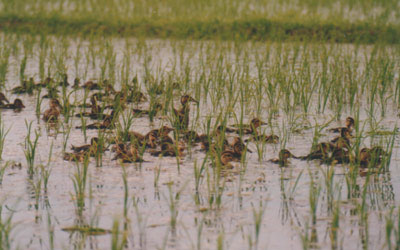
3. No-till Farming Method
A farming method that produces rice without disturbing the soil through tillage.
By doing this, you can see a traditional and natural scenes such as fireflies and loaches breed in the paddy fields and many birds passing by the field.
This method is very attractive because it only requires half fuel for the farming work, and suppress the methane gas which has a strong environmental impact.

It can also cultivate extreme phase bacteria and extreme phase bacteria compost.
4. Paper Multi Farming Method
It is a farming method using recycled paper for environmentally friendly agriculture.
It uses recycled paper and weeds to produce suppression effect.
Since recycled agricultural paper is decomposed by the microorganisms in the rice fields, it is unnecessary to collect it.
No pesticides or chemical fertilizers are used for this farming method.
Along with the delicious taste, we deliver the "safe and secure" food.
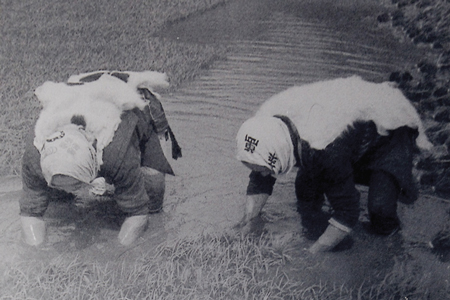
The picture shows the former rural scenery.
Message from Rice Producer
In recent years, the concern for the safety of agricultural and livestock products has grown enormously.
The modernization and productivity improvement principal of agriculture from the postwar era turned agriculture products into chemical-based products, so consumers will have to pay for the consequence.
Considering those backgrounds, the price might be cheap although it is in large quantity.
Meanwhile in present, people become more consumptive.
Maybe it is best to not only concerned about the taste and quality, but also about the food safety as well.
Because there are people who are concerned about the food safety, agricultural products such as “pesticide-free” are currently in trend.
However, there are standards for those "pesticide-free" products. And there are many different cultivation methods.
We are building a safe and delicious farming method from many of those methods that are pesticide-free and doesn't use any chemical fertilizer.

- 1. Keep on maintaining the field's fertility to make the constitution of rice stronger.
It will make the rice plant become strong against diseases and pests. - 2. Reduce the number of chemical fertilizers and use natural fertilizer instead to harvest rich and nutritious food.
It is The Suda Corporation's way of thinking about agriculture.
Rice can actually grow even without pesticides and fertilizers.
It can grow with the original power from the rice, and it can still grow without human's hands.
That is the awaken power from the plants.
Besides, if you give only natural fertilizers to it, you can make safe rice grown only with substances that exist in nature.
With this statement as our base, we are providing brown rice, white rice, and black rice based on the four farming methods (Natural Return Farming Method, Aigamo Farming Method, No-till Farming Method, and Paper Multi Farming Method).
- The Presentative from Suda Corporation, Ms. Meiko Suda.
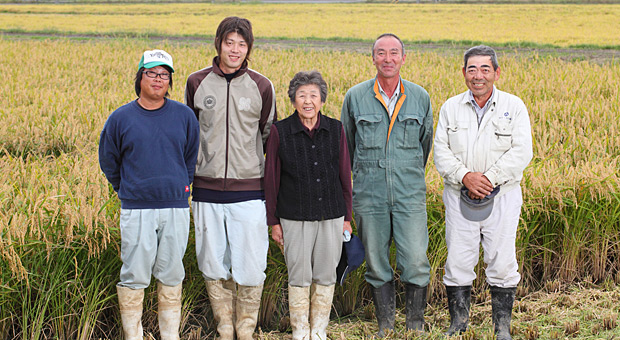
Product Details
| Name | Pesticide-Free "Sasanishiki" Brown Rice 1 kg |
|---|---|
| Place of Origin | Akita Prefecture |
| Rice Variety | Sasanishiki |
| Details Details |
・ Chemically synthesized pesticides: not used during cultivation ・ Chemical fertilizer: not used during cultivation period |

Why shop with KAWASHIMAYA?
- We sell only authentic and high-quality products
- 100% Made in Japan products are as listed
- Organic and non-GMO products are as listed
- All products are new and have long expiry date
- All products are handled directly from our warehouse in Tokyo, Japan
- Easy and secure payment options with CC or PayPal
- Safe and insured international shipping methods
- English and Japanese customer support by email
- Wholesale discount prices available for selected products
- Find insightful articles from KAWASHIMAYA Blog
- Get exclusive discounts for KAWASHIMAYA Newsletter subscribers
- Easy shop on KAWASHIMAYA Amazon USA

